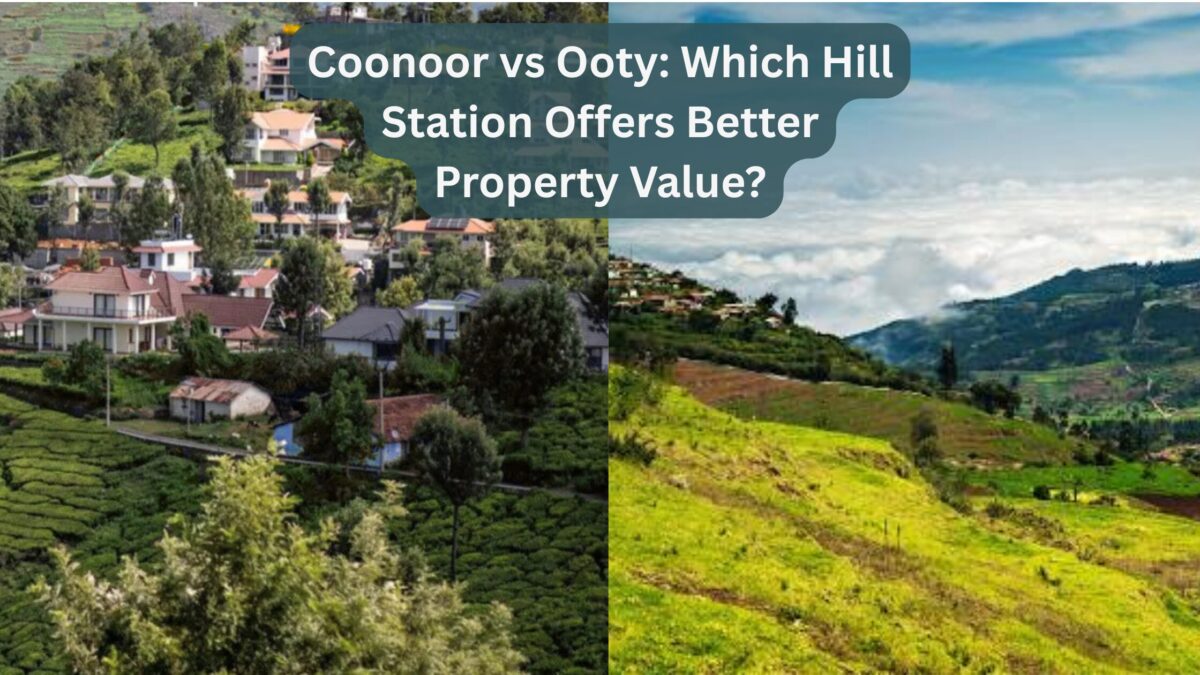If you’ve ever dreamt of owning a home in the lap of nature, surrounded by misty mountains, lush green tea estates, and pleasant weather all year round, chances are you’ve considered Ooty or Coonoor. Both are beautiful hill stations in Tamil Nadu’s Nilgiris district, popular among tourists and increasingly loved by property buyers. But when it comes to real estate value—Coonoor vs Ooty—which one truly makes more sense?
Let’s break it down in simple terms and help you decide where your next hill home or investment should be.
1. Overview of Coonoor and Ooty as Real Estate Destinations
Ooty, also known as Udhagamandalam, has been the go-to hill station for decades. It’s busier, has more tourist footfall, and is more commercial. Coonoor, on the other hand, is quieter, more peaceful, and ideal for those looking for a tranquil lifestyle.
According to tourism stats, Ooty gets over 2.5 million tourists annually, while Coonoor gets around 50,000–60,000. This alone shows how commercial Ooty has become compared to Coonoor.
From a real estate point of view, that also means Ooty properties may be more expensive, especially in the centre. Coonoor offers better value-for-money, particularly for those looking at long-term stays or peaceful retirement homes.
2. Property Price Comparison
Let’s talk numbers. Based on 2024 listings and local broker insights:
| Location | Average Land Price (per sq. ft.) | Average Villa Price | Rental Yield (Yearly) |
| Ooty | ₹3,000 – ₹5,500 | ₹80 lakh – ₹2.5 Cr | 2.5% – 4% |
| Coonoor | ₹1,800 – ₹3,500 | ₹50 lakh – ₹1.5 Cr | 3% – 6% |
If you’re looking for plots in Coonoor, they come with better views, lower rates, and higher appreciation potential, especially in areas like Sim’s Park Road and Bedford.
Ooty, while attractive, sees more property saturation and inflated prices, especially in prime touristy zones like Elk Hill and Fern Hill.
3. Infrastructure and Development
Both hill stations have decent infrastructure, but Ooty has an edge in commercial facilities—you’ll find more schools, hospitals, hotels, and marketplaces.
However, Coonoor is catching up with premium gated communities, better road connectivity, and improved internet facilities (a big plus for remote workers). The Nilgiris district administration has also pushed for eco-friendly real estate development in Coonoor, making it ideal for sustainable housing.
If you’re a nature-lover or planning to settle down post-retirement, Coonoor wins with its quiet roads and cleaner surroundings.
4. Real Estate Investment Trends (2023–2025)
Over the last 3 years, real estate in Coonoor has seen a steady 8–12% price appreciation annually, especially for plotted developments and colonial-style villas.
Ooty, being already saturated, has seen slower appreciation—around 4–6% yearly.
NRIs, IT professionals, and retirees are increasingly investing in Coonoor as it offers both lifestyle benefits and capital gains. In fact, more than 60% of recent buyers in Coonoor were from cities like Bengaluru, Chennai, and Hyderabad.
Coonoor is emerging as the preferred weekend home destination due to lesser traffic and better privacy compared to Ooty.
5. Legal and Regulatory Considerations
Buying property in any hill station in Tamil Nadu comes with certain rules. You need to:
- Verify land classification (agriculture vs residential)
- Obtain a Non-Agricultural (NA) certificate if required
- Ensure the property is RERA registered (for under-construction projects)
In Coonoor, the process is slightly smoother due to lower demand pressure, so documentation and approvals are faster. It’s also easier to buy plots in Coonoor directly from landowners or through local developers.
Ooty, however, has more restrictions and higher scrutiny due to the pressure on natural resources and over-tourism concerns.
6. Property Types Available
In Ooty:
- Studio and 2BHK apartments
- Villas in gated communities
- Premium cottages for short-term rental
In Coonoor:
- Open plots with mountain views
- Colonial bungalows (some over 100 years old)
- Custom-built hillside villas
- Gated farm-style communities
If you want freedom to build and design, plots in Coonoor are your best bet.
7. Lifestyle, Pollution & Peace
Let’s be honest—Ooty has become crowded and commercialised. Traffic jams during tourist season are common. There’s also more construction and garbage-related issues due to the tourism load.
Coonoor offers a more peaceful and clean living experience. It has:
- Better air quality
- Lesser tourist traffic
- More community-driven living
- A stronger focus on greenery and conservation
If you’re looking to wake up to the sound of birds instead of car horns, Coonoor wins hands down.
8. Who Should Choose What?
| Buyer Type | Best Option | Reason |
| Retirees | Coonoor | Peaceful, health-focused, green |
| Families with Kids | Ooty | More schools, hospitals |
| Weekend Home Seekers | Coonoor | Better privacy, lower cost |
| Short-Term Rental Hosts | Ooty | Tourist demand |
| Long-Term Investors | Coonoor | Higher appreciation, better deals |
9. Pros and Cons Table
| Factor | Coonoor Pros | Ooty Pros |
| Pricing | Lower, more VFM plots & villas | High-end demand-based pricing |
| Crowd Level | Low | High (especially in season) |
| Nature | More greenery, less pollution | Slightly more developed areas |
| Property Choice | Plots, bungalows, colonial homes | Apartments, cottages |
| ROI | Higher for long-term | Better for short-term rentals |
10. Final Verdict
If you’re looking at value, peaceful living, and long-term appreciation, real estate in Coonoor is the smarter choice. It’s still developing, which means there’s room for growth. You can find beautiful plots in Coonoor with mountain views for under ₹25 lakhs—a deal you won’t get in Ooty anymore.
But if you want to run a guesthouse or earn from short-term stays, Ooty’s tourist crowd can work in your favour.
In the end, the choice depends on your purpose—but if you’re planning to settle down or invest for the long term, Coonoor offers better property value hands down.





